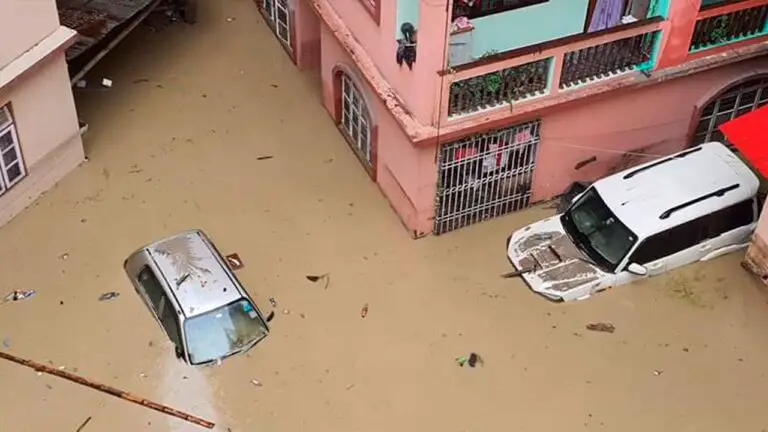Deadly Floods Hit India’s Himalayan Northeast
Ice-cold floodwaters swept through the picturesque mountain towns of India’s Himalayan northeast, claiming the lives of at least 31 people. These raging waters not only destroyed homes and bridges but also prompted thousands to flee their residences. The catastrophe unfolded shortly after midnight on a Wednesday when the waters from an overflowing glacial lake breached Sikkim State’s largest hydroelectric dam and then inundated the valleys below.
This disaster marks the latest in a series of deadly floods that have struck northeast India, driven by a year of unusually heavy monsoon rains. In the nearby Himachal Pradesh state, nearly 50 people lost their lives in flash floods and landslides in August. Also, record-breaking rains in July resulted in over 100 fatalities over two weeks in northern India.
Massive Rescue Operation
More than 2,000 individuals were successfully rescued following Wednesday’s deluge, as reported by the Sikkim State Disaster Management Authority. In response to the crisis, state authorities swiftly established 26 relief camps to shelter over 22,000 affected individuals.
Efforts to locate approximately 100 missing persons, including 22 soldiers, are ongoing. Vinay Bhushan Pathak, Sikkim’s top bureaucrat, revealed that 26 people sustained injuries, while nearly 3,000 tourists found themselves stranded in flood-affected areas alongside 700 taxi drivers. Pathak added that helicopters provided by the army and air force are being used for evacuations.
Causes and Consequences
The South Llonak Lake has experienced rising water levels in recent years due to melting glaciers driven by a warming climate. This increasing pressure on the dam’s integrity made it vulnerable to breaching, although the precise trigger remains uncertain. Experts and various government reports suggest a combination of sudden intense rains in the region and a 6.2 magnitude earthquake that struck nearby Nepal on Tuesday.
The floodwaters washed away eleven bridges in the Lachan Valley, damaged pipelines, and destroyed over 270 houses across four districts. Dikchu and Rangpo, among other towns in the Teesta basin, were submerged, and schools in four districts were closed until Sunday.
Devastating Impact on Infrastructure
The floodwaters also impacted several army camps, burying vehicles under layers of mud. The Press Trust of India news agency reported that four soldiers’ bodies were discovered in neighboring West Bengal, although it remains unclear if they are among the 22 missing soldiers or a separate incident. Fortunately, one soldier initially reported missing was later found by authorities.
The Indian army is providing medical aid and phone connectivity to civilians in the affected areas. Prime Minister Narendra Modi’s office has pledged government support for state authorities dealing with the aftermath of this devastating flooding.
Hydropower Project and Ongoing Risks
The Teesta 3 hydropower project, located on the Teesta River, has been operational since 2017. Costing $1.5 billion to construct and with the capacity to generate 1,200 megawatts of electricity, the project was a significant power source for Indian homes. Despite the increasing frequency of extreme weather and the potential risks to dams, the Indian federal government aims to boost the country’s hydroelectric dam output to 70,000 megawatts by 2030.
Rising Environmental Concerns
Landslides and floods, exacerbated by global warming’s impact on glacier melting, are distressingly common in India’s Himalayan region during the June-September monsoon season. This cascade of events underscores the growing frequency of such disasters as climate change continues to affect the region. Scientists warn that without effective climate control measures, Himalayan glaciers could lose up to 80% of their volume, making these tragic events more frequent.
In conclusion, the devastating floods in India’s Himalayan northeast serve as a stark reminder of the urgent need to address climate change and its profound impacts on the environment and communities.

